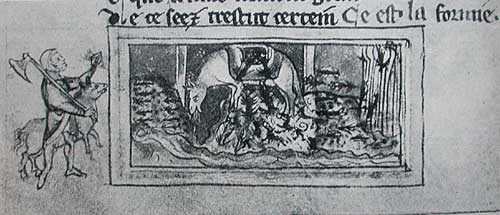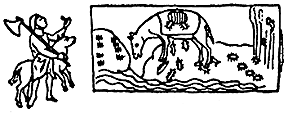A bestiary, a literary genre from the Middle Ages, is a collection of short descriptions about all sorts of animals, real and imaginary, accompanied by a moralizing allegory. Although a bestiary deals with the natural world it was never meant to be a scientific text and should not be read as such. Some observations may be quite accurate but they are given the same weight as totally fabulous accounts (Aberdeen Bestiary Project 1995). See the section "Medieval Bestiaries and the Birth of Zoology" for a more complete description of bestiaries and their history.
A creature called an "ant-lion" appears in some bestiaries and related manuscripts. Since bestiary manuscripts are ultimately derived from the symbolic Greek-Christian book called the Physiologus, some texts featured the old Physiologus-style ant-lion which, according to the moral, died of starvation at birth because of its dual nature (half ant, half lion). Other bestiaries utilized the even older story of the gold-digging ant-lions first described by Hêródotos around 430 B.C.E. As the bestiaries drifted from their sources, geographically and historically, ant-lions were replaced by insect ants (Kevan 1992). Figures 1 through 3 show ant-lion illustrations from French and English bestiaries.

| |
| Figure 1. Illustration from the 13th century French bestiary of Guillaume le Clerc (Bibliothèque Nationale, Paris, MS fr 14969, folio 17). The central scene depicts the story of the fierce gold-guarding "Ethiopian ants" of antiquity. Numerous ants are running up and down the legs of a "decoy" horse, depositing gold sand in the pack saddle. The scenes on either side relate the story of the common ant. On the left is an ant hill with about a dozen ants on it. On the right is standing corn with many ants passing to and fro between it and the ant hill. (Druce 1923 and Kevan 1992). | |
| Figure 2. This is an outline adaptation of the Guillaume le Clerc illustration in fig. 1. (McCulloch 1962). |  |
| Figure 3. The early 14th century Queen Mary's Psalter (British Library, London, MS Royal 2 B vii, folio 96) shows the "Ethiopian ants" (ant-dogs) attacking armed gold robbers. (Druce 1923 and Kevan 1992). |

|
